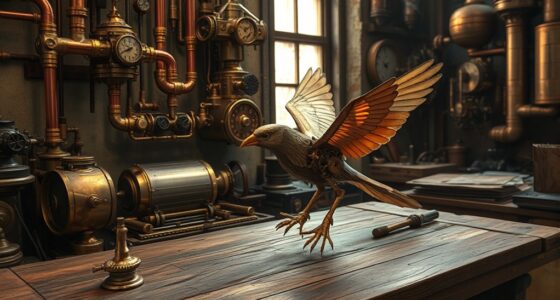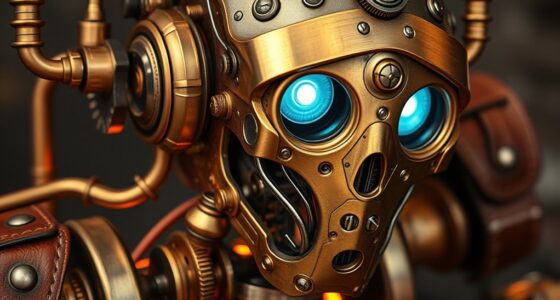Retro-futurism, especially through steampunk, reimagines the future with a unique twist. You'll find Victorian-inspired aesthetics mixed with imaginative technology, creating a world where steam power reigns and vintage design meets fantastical innovation. Think elegant gears, brass fixtures, and creative machines that blend nostalgia with adventure. This genre not only celebrates human ingenuity but also offers social commentary on technology's role in society. There's much more to explore about this captivating vision of tomorrow.
Key Takeaways
- Retro-futurism combines past visions of technology with modern aesthetics, showcasing a nostalgic reflection on innovation and societal progress.
- Steampunk envisions a world powered by steam technology, merging Victorian-era design with fantastical elements and imaginative machinery.
- Aesthetically, steampunk features brass, copper, and intricate designs, emphasizing craftsmanship and a DIY ethos in fashion and decor.
- Transportation innovations in steampunk include airships, steam trains, and ornithopters, blending old and new technologies for adventurous exploration.
- The future of retro-futurism calls for balancing nostalgia with sustainability, prompting reevaluation of technology's role in society and inspiring creativity.
Defining Retro-Futurism
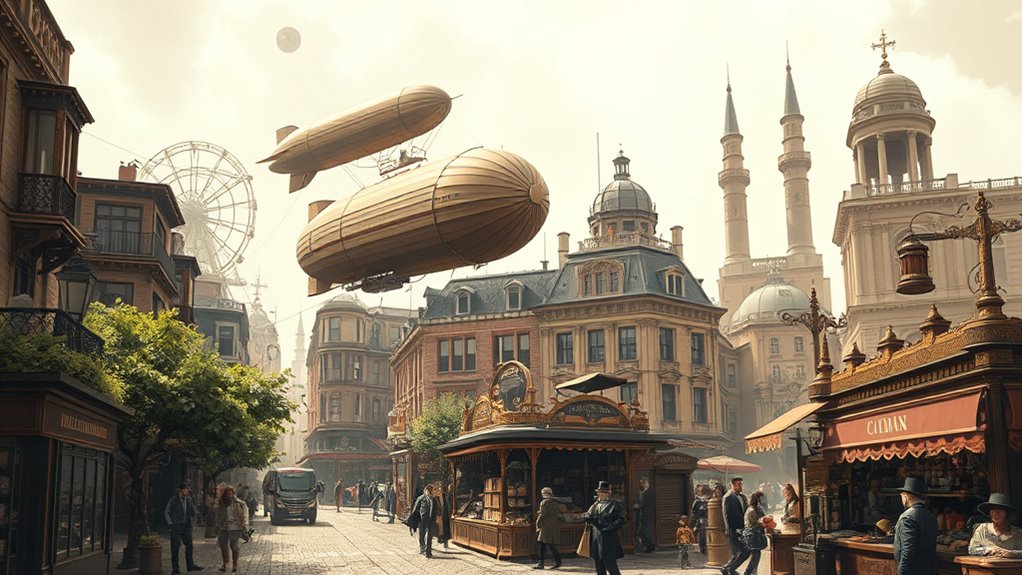
Retro-futurism is a captivating blend of past visions and modern aesthetics that invites you to explore how people once imagined the future.
Emerging in the 1960s and 1970s, this style reflects an optimistic view of technological progress, showcasing vibrant colors and grungy aesthetics. Retro-futurism notably combines futuristic technology and themes with old-fashioned design elements, creating a unique aesthetic that resonates with many.
Emerging in the 1960s and 1970s, retro-futurism captures an optimistic vision of technology with vibrant colors and a grungy aesthetic.
You'll notice its unique visual elements, like rounded geometric shapes and cyber-inspired typography, which create a distinct look.
Drawing inspiration from science fiction and early technological predictions, retro-futurism often depicts eccentric gadgets, robots, and futuristic cities.
It serves as a nostalgic reflection on the unfulfilled promises of technology, allowing you to appreciate both the excitement and disappointment of past visions.
This artistic expression provides a fascinating lens through which to view our evolving relationship with technology.
The Essence of Steampunk
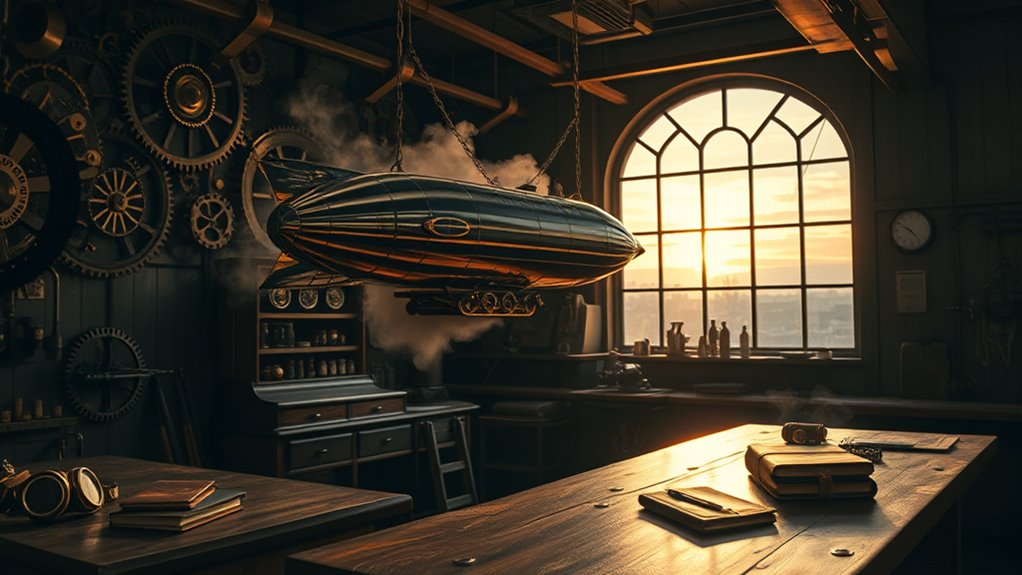
While exploring the essence of steampunk, you'll find a rich tapestry woven from history, technology, and imagination.
Rooted in the Victorian era, steampunk reimagines the past with steam-powered machinery and advanced technologies that never fully materialized. This genre blends science fiction with fantasy and historical fiction, crafting unique narratives that often diverge from traditional timelines, especially around the Industrial Revolution. Alternative history settings allow for exploration of societal impacts and political tensions in ways that resonate with contemporary issues.
You'll encounter inventors and adventurers pushing the boundaries of innovation, while social issues are explored through alternate historical lenses.
Steampunk's cultural impact extends beyond literature, influencing fashion, art, and subcultures. Its DIY ethos encourages creativity, allowing you to transform modern objects into imaginative designs, all while celebrating a retro-futuristic vision of what could have been.
Aesthetic Characteristics of Steampunk
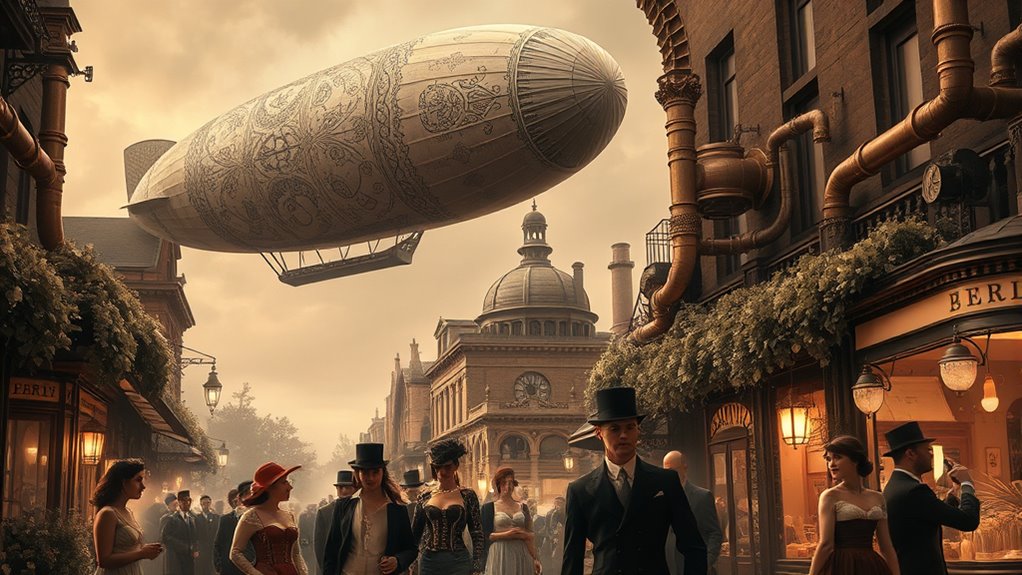
Steampunk's aesthetic characteristics draw you into a world where the past and future collide, creating a distinctive visual experience.
You'll notice polished wood and leather, giving a natural warmth that contrasts with the metallic elements. Brass and copper dominate, showcasing intricate filigree and piping that enhance the industrial vibe. Stained glass adds vibrant colors, evoking an antique feel throughout your surroundings. Incorporation of natural elements promotes tranquility, reflecting the calming atmosphere that steampunk aesthetics can provide.
Expect to see gears and clockwork integrated into art and decor, reflecting a DIY spirit. Architectural designs often echo Victorian styles, featuring airship docks and clock towers. Natural materials are essential in steampunk, as the genre avoids plastics and fossil-based products to maintain its retro charm.
In fashion, corsets and goggles blend with mechanical embellishments, while leather and lace create a rugged elegance.
Steampunk embraces a unique aesthetic that feels both nostalgic and futuristic.
The Role of Technology in Steampunk
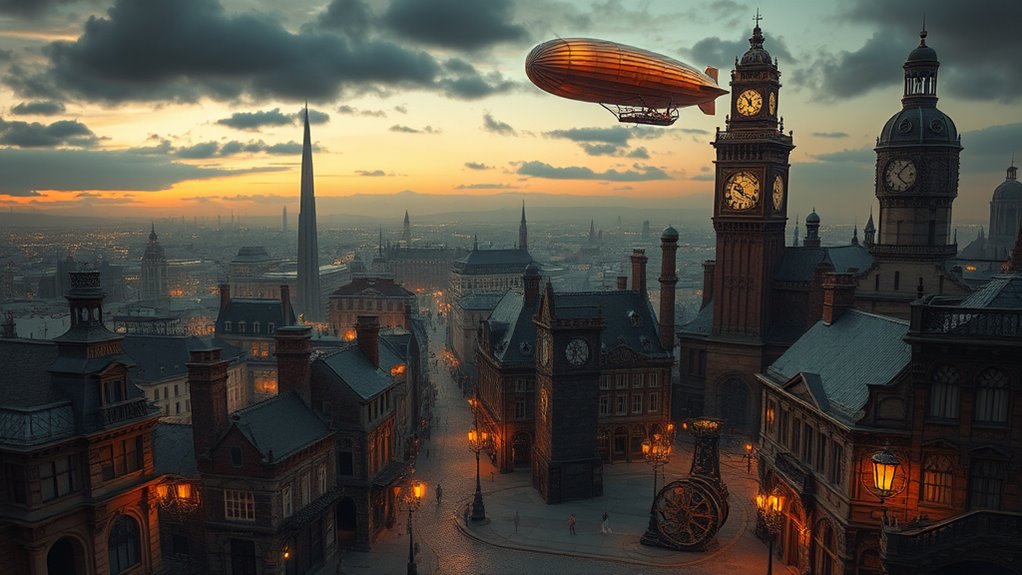
As you delve into the world of steampunk, you'll discover that technology plays a pivotal role in shaping its unique narrative. Central to this genre is steam power, which reflects Victorian-era innovations and the Industrial Revolution's advancements. You'll encounter steam-powered automatons and imaginative machines inspired by visionaries like H.G. Wells and Jules Verne. Steampunk celebrates human ingenuity, blending mechanical designs with fantastical elements, often using alternative energy sources like aether and solar power. This retro-futuristic lens encourages you to rethink our reliance on digital technology while exploring how steam-driven innovations might've reshaped society. Ultimately, steampunk's technology invites you to engage with a world where creativity and engineering intertwine, creating a harmonious blend of past and future. The essence of steampunk lies in the combination of historical elements and hypothetical advancements, merging Victorian aesthetics with imaginative technology.
Transportation Innovations in Steampunk
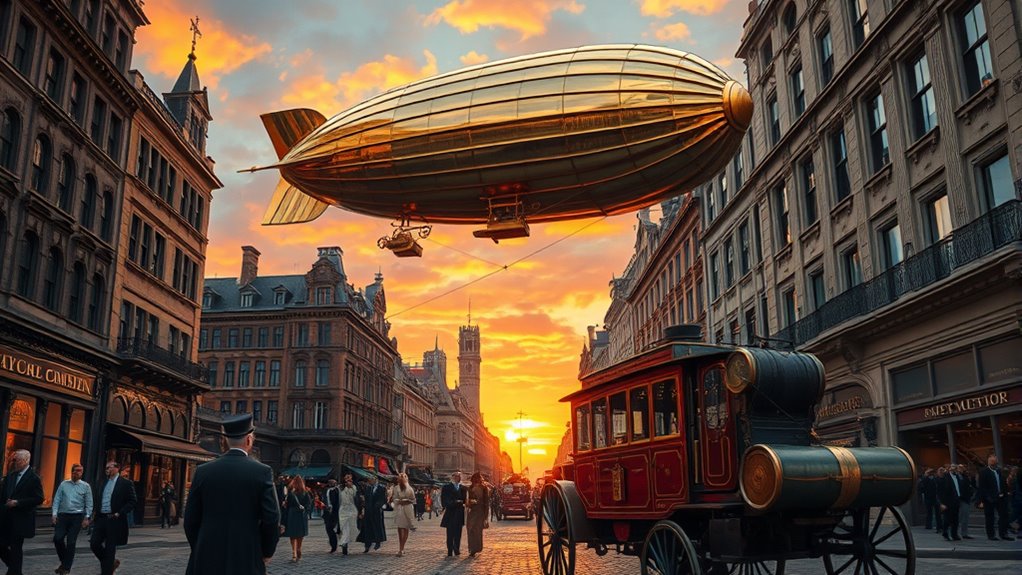
In exploring the imaginative realms of steampunk, transportation innovations stand out as a fascinating intersection of creativity and engineering.
You'll encounter airships gliding gracefully through the skies, propelled by steam engines, a staple in steampunk fiction.
Steam trains revolutionize land travel with their coal-powered boilers, while ornithopters, though impractical, capture the allure of flight with their flapping wings. Steam-powered vehicles are a hallmark of this genre, showcasing the blend of technology and fantasy.
Hot air balloons and horse-drawn vehicles blend the old with the new, creating a unique urban landscape.
Advanced submarines, inspired by Jules Verne, offer underwater adventures, while zeppelins soar as symbols of high-powered travel.
Each mode reflects a Victorian aesthetic, marrying form with function, and inviting you to dream of a world where imagination drives innovation.
Historical Context and Influence
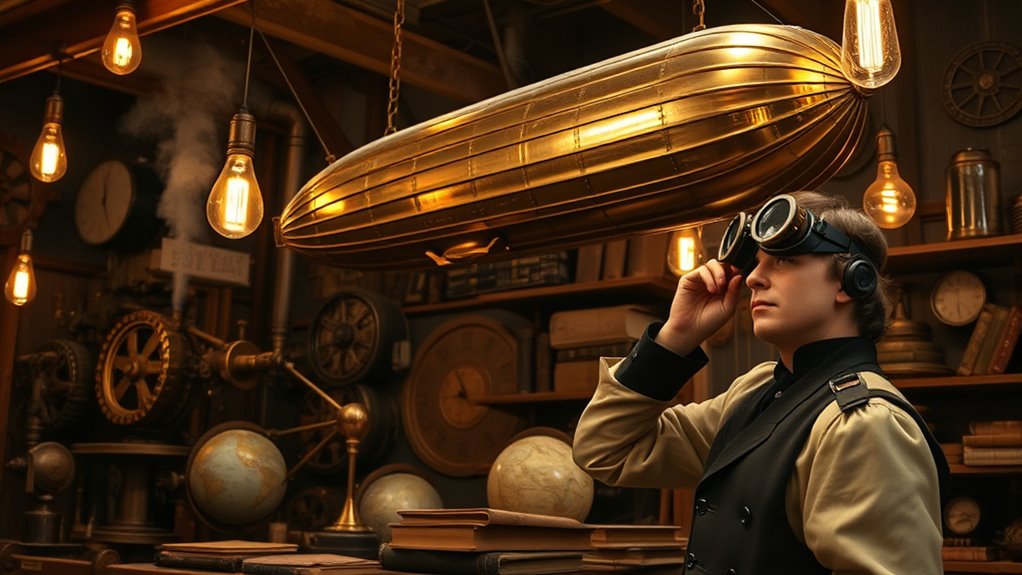
While delving into the historical context and influence of steampunk, you'll find that it thrives on the rich tapestry of the Victorian era, a time marked by dramatic technological advancements and a rigid social hierarchy. The Industrial Revolution profoundly impacted the steampunk aesthetic, introducing steam-powered machinery that shaped its narratives. You'll notice the literary roots of steampunk in the works of Jules Verne and H.G. Wells, whose imaginative tales blend historical settings with science fiction. Additionally, the genre often reflects the class divide prevalent during this era, emphasizing the contrast between the wealthy elite and working-class characters. Elements of the American West also color many steampunk stories, adding adventure and exploration.
Steampunk in Modern Media
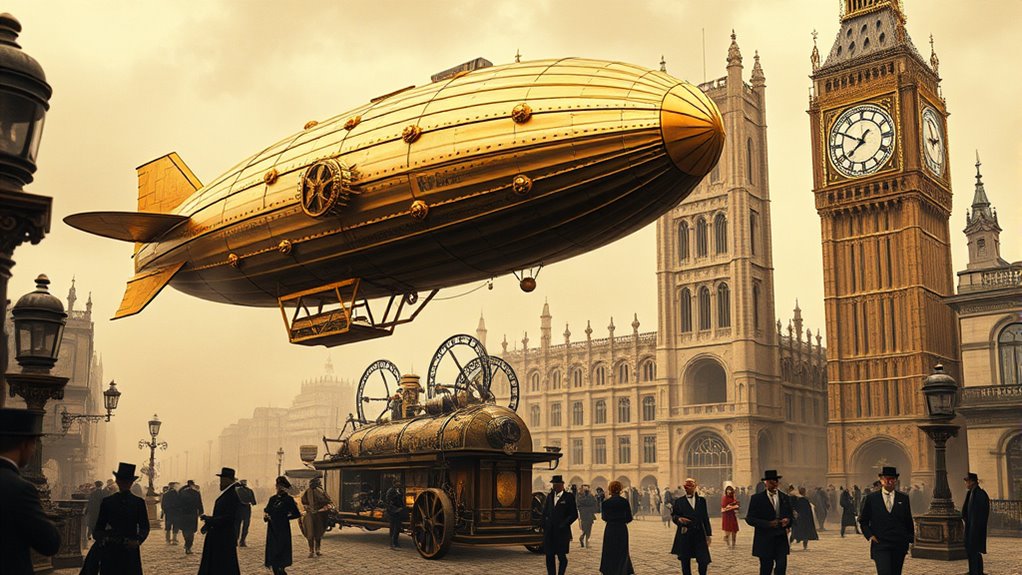
Steampunk's allure has seamlessly permeated modern media, bringing its unique aesthetic and imaginative narratives to a wider audience.
You can see its influence in films like *The Wild Wild West* and *Alice Through the Looking Glass*, where steam-powered technology and whimsical designs come to life.
Television shows such as *Doctor Who* and *Penny Dreadful* incorporate steampunk elements, enriching their storytelling with Victorian charm. Notably, *Doctor Who* often references 19th-century scientific romances, showcasing the genre's literary origins.
Television series like *Doctor Who* and *Penny Dreadful* masterfully weave steampunk aesthetics into their captivating narratives.
In gaming, titles like *Bioshock Infinite* and the *Dishonored* series showcase intricate worlds filled with steampunk gadgets.
Anime, too, embraces this style; *Kabaneri of the Iron Fortress* and *Fullmetal Alchemist* blend fantastical elements with steam technology.
Cultural Reflections of Steampunk

As you delve into the cultural reflections of steampunk, you'll discover a rich tapestry woven from historical influences and modern interpretations.
Steampunk draws heavily from the Victorian Era, showcasing ornate designs and a critique of social hierarchies. The Industrial Revolution's impact is evident, as imaginative technologies emerge from an alternative history where steam power reigns. The genre is influenced by 19th-century scientific romances, highlighting its roots in literary history.
You'll find the subculture thriving in distinctive fashion, art, and music, fostering a DIY spirit among enthusiasts. This aesthetic embraces muted colors and neo-Victorian styles, often merging with mainstream fashion.
Steampunk also serves as social commentary, addressing class divides and technological dependency while celebrating craftsmanship.
Ultimately, it reflects a longing for a tangible, creative past amidst today's mass-produced culture.
The Future of Retro-Futurism and Steampunk
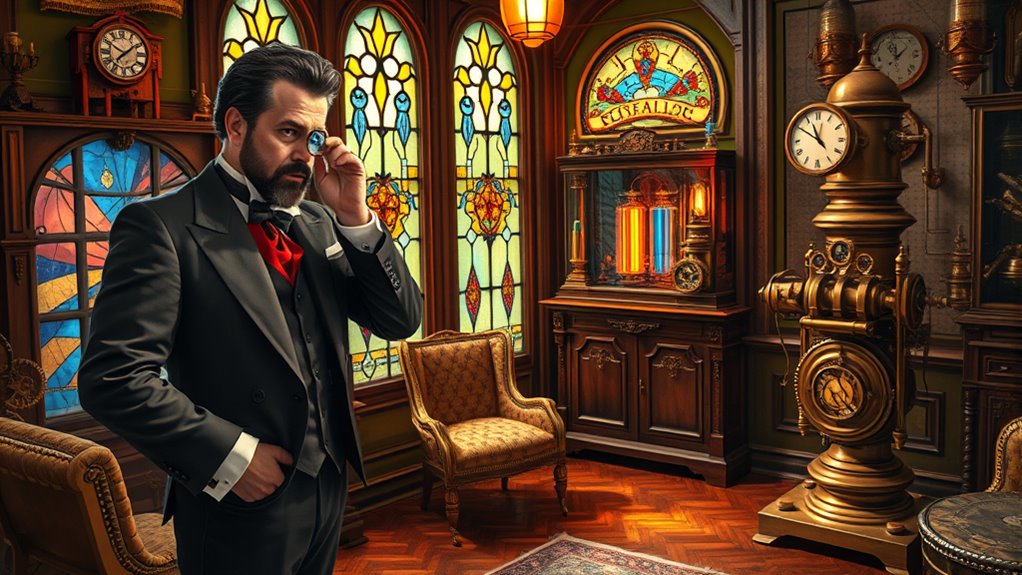
Retro-futurism and steampunk are poised to evolve in exciting ways as they adapt to contemporary society's needs and desires. You'll notice a blend of nostalgia and innovation shaping future technologies, as retro-futuristic themes increasingly influence design, fashion, and consumer products. The entertainment industry is embracing these aesthetics more than ever, with films, games, and literature exploring alternate histories and societal commentary. As you engage with these stories, expect to see new genres emerge, like atompunk and dieselpunk, reflecting modern sensibilities. However, retro-futurism faces challenges, including balancing nostalgia with sustainability and accessibility. Retrofuturism serves as a reminder of forgotten ideals and aspirations from previous generations, prompting a reevaluation of the role of technology in our lives.
Frequently Asked Questions
How Does Steampunk Differ From Other Retro-Futuristic Styles?
Steampunk differs from other retro-futuristic styles primarily through its Victorian-inspired aesthetic and steam-powered technology.
You'll notice it emphasizes intricate machinery, elegant fashion, and imaginative inventions, setting it apart from genres like cyberpunk or atompunk, which focus on digital and atomic themes.
While steampunk embraces a sense of nostalgia and craftsmanship, others often delve into darker or more futuristic visions, creating distinct atmospheres and cultural influences in their narratives and visuals.
What Are Some Popular Steampunk Literature Examples?
Imagine a world where brass gears whir and steam hisses from fantastical machines.
In steampunk literature, you'll find gems like *Twenty Thousand Leagues Under the Sea*, where Jules Verne's imaginative inventions come to life.
K.W. Jeter's *Morlock Night* reimagines Victorian England, while *The Difference Engine* by Gibson and Sterling alters history with Babbage's computer.
Cherie Priest's *Boneshaker* blends zombies with steam-powered wonders, captivating your imagination in every page-turn.
How Can I Incorporate Steampunk Elements Into My Home Decor?
To incorporate steampunk elements into your home decor, start by mixing materials like leather, wood, and metals.
Use warm colors for walls and furniture, and add vintage items like old clocks and gears. Incorporate steampunk lamps for unique lighting and display vintage maps for an adventurous touch.
Don't forget to repurpose mechanical parts into decorative pieces.
Tools like HomeDesigns AI can help you visualize these elements in your space for a cohesive look.
Are There Steampunk Festivals or Conventions I Can Attend?
You won't believe the sheer number of steampunk festivals happening soon!
You can dive into the whimsical world of steampunk at events like the Wild Wild West Steampunk Convention in Tucson, AZ, or the Chicago Steampunk Exposition.
If you're looking for a unique blend of history and creativity, don't miss TeslaCon in Madison, WI.
Each festival offers workshops, performances, and interactive activities, so you'll definitely find something that sparks your imagination!
What Role Does DIY Culture Play in the Steampunk Community?
DIY culture plays a vital role in the steampunk community by encouraging you to engage creatively with historical aesthetics and modern technology.
It fosters inclusivity, inviting individuals from diverse backgrounds to participate in crafting unique items. Through experimentation and knowledge-sharing, you can develop new skills and showcase your work at community events.
This hands-on approach not only supports sustainability but also critiques mass production, making your creations meaningful and reflective of personal expression.
Conclusion
As you step into the vibrant world of retro-futurism and steampunk, you're not just gazing at a whimsical past but embracing a bold vision of what could be. The gears of imagination turn endlessly, blending history with dreams, crafting a tapestry where the mechanical and the magical collide. So, let your spirit soar on a brass-bound airship, and remember—every invention starts as a flicker of inspiration, waiting for you to bring it to life.


